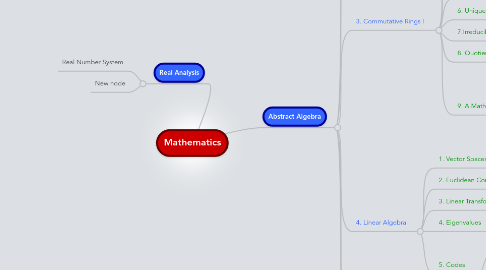
1. Real Analysis
1.1. Real Number System
1.2. New node
2. Abstract Algebra
2.1. 1. Number Theory
2.1.1. 1. Induction
2.1.2. 2. Binomial Theorem and Complex Numbers
2.1.3. 3. Greatest Common Divisors
2.1.4. 4. Fundamental Theorem of Arithmetic
2.1.5. 5. Congruences
2.1.6. 6. Dates and Days
2.2. 2. Groups I
2.2.1. 1. Set Theory
2.2.1.1. Functions
2.2.1.2. Equivalence Relations
2.2.2. 2. Permutations
2.2.3. 3. Groups
2.2.3.1. Symmetry
2.2.4. 4. Subgroups and Lagrange's Theorem
2.2.5. 5. Homomorphisms
2.2.6. 6. Quotient Groups
2.2.7. 7. Group Actions
2.2.8. 8. Counting with Groups
2.3. 3. Commutative Rings I
2.3.1. 1. First Properties
2.3.2. 2. Fields
2.3.3. 3. Polynomials
2.3.4. 4. Homomorphisms
2.3.5. 5. From Numbers to Polynomials
2.3.5.1. Euclidean Rings
2.3.6. 6. Unique Factorization
2.3.7. 7.Irreducibility
2.3.8. 8. Quotient Rings and Finite Fields
2.3.9. 9. A Mathematical Odyssey
2.3.9.1. Latin Squares
2.3.9.2. Magic Squares
2.3.9.3. Design of Experiments
2.3.9.4. Projective Planes
2.4. 4. Linear Algebra
2.4.1. 1. Vector Spaces
2.4.1.1. Gaussian Elimination
2.4.2. 2. Euclidean Constructions
2.4.3. 3. Linear Transformations
2.4.4. 4. Eigenvalues
2.4.5. 5. Codes
2.4.5.1. Block Codes
2.4.5.2. Linear Codes
2.4.5.3. Decoding
2.5. 5. Fields
2.5.1. 1. Classical Formulas
2.5.1.1. Viete's Cubic Formula
2.5.2. 2. Insolvability of the General Quintic
2.5.2.1. Formulas and Solvability by Radicals
2.5.2.2. Quadratics
2.5.2.3. Cubics
2.5.2.4. Quartics
2.5.2.5. Translation into Group Theory
2.5.3. 3. Epilog
2.6. 6. Groups II
2.6.1. 1. Finite Abelian Groups
2.6.2. 2. The Sylow Theorems
2.6.3. 3. Ornamental Symmetry
2.7. 7. Commutative Rings II
2.7.1. 1. Prime Ideals and Maximal Ideals
2.7.2. 2. Unique Factorization
2.7.3. 3. Noetherian Rings
2.7.4. 4. Varieties
2.7.5. 5. Generalized Division Algorithm
2.7.5.1. Monomial Orders
2.7.5.2. Division Algorithm
2.7.6. 6. Grobner Bases
